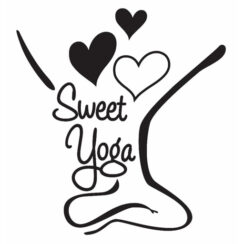Frequently Asked Questions
Yoga is an ancient spiritual discipline that originated in India several thousand years ago. It is the science of consciousness and includes many practices. The two most familiar to Westerners are Hatha Yoga (yoga of the body) and Raja Yoga (meditation). Historically, they were meant to go together. Hatha Yoga quiets the mind and prepares the body to sit for meditation. However, in the West Hatha Yoga is often practiced as a form of exercise that may or may not include meditation. Many different styles are practiced in the United States, all of which strengthen and stretch the body in a variety of ways.
Sweet Yoga’s practices are largely derived from Svaroopa® Yoga. The emphasis of this style of yoga is removing the spinal compression that blocks our experience of consciousness and creates illness and injury in the body. The practice is profoundly healing on physical, mental/emotional, and spiritual levels. It is easy to learn and accessible for almost any fitness level. Repeated practice results in increased physical health and vitality, clarity and peace of mind, and personal experiences of svaroopa, which in Sanskrit means “the bliss of your own being.”
Those who have organ transplants or are taking immunosuppressant medication should not practice Svaroopa® yoga. It dramatically improves the condition of the immune system and may compromise the organ transplant. This does not include individuals with hip and knee replacements, who can safely practice Svaroopa® yoga with modifications and receive many benefits from doing so. It also does not include those who have autoimmune conditions such as multiple sclerosis, lupus, or rheumatoid arthritis. People with these illnesses can safely practice and receive many benefits from the balancing effects of the yoga on the immune system and the strengthening of the nervous system.
The practice is very accessible to newcomers because it supports the body fully with propping and pose modifications so that the deep tensions in the spine begin to release. So you never have to worry about not being able to do a pose because there are always options available to accommodate your body. And as you practice more, your body opens up in new ways, so that you can extend your range of motion and explore poses on a deeper level, all without forcing or straining. Thus the same practice is suitable for both newcomers and long-standing students, but experienced very differently.
Sweet Yoga sessions are organized by theme so that you get a variety of different releases in the body and learn how to keep your spine open in your daily life. Some themes, such as standing poses and vinyasa (flowing sequences), are active and some are more meditative (neck and shoulders, forward bends, and lower spinal release). All classes help you to release deep tensions in the spine, increase your strength, flexibility and balance and quiet your mind. Sweet Yoga will particularly appeal to those who are looking to relieve physical discomfort, improve overall health and well-being, experience more ease in the body and become more comfortable with stillness. It is also of particular interest to those who have a yearning for something more from their yoga practice than just the physical postures – an experience of inner clarity, self-knowledge, and bliss.
A typical class begins and ends in Shavasana, yoga’s pose of deep relaxation. The body is fully supported so that the deeply held tensions in the spine can begin to dissolve. From there, we move on to a breathing practice such as Ujjayi Pranayama, the primary breathing practice of Svaroopa® Yoga. This breathing practice increases prana, the body’s life force, which speeds recovery from injury or illness, increases vitality and stamina and reduces fatigue.
Ujjayi pranayama also balances the immune system, helping students with autoimmune conditions, allergies and colds or flu. Following the breathing practice, we explore a series of asanas (or poses) related to a particular theme. A typical class includes between 9 and 16 poses, which are held for 45 seconds to a couple of minutes, to allow for softening. Propping and pose modifications are used for every student so that the practice is individualized to accommodate each person’s needs.
Sweet Yoga’s distinction lies in the intention of the practice: To create core opening by releasing tension in the deepest layers of the body. This release deliberately begins at the tailbone – the pivot point of the body – and is carried up the spine, through the sacrum, waist, ribcage, and beyond. As this release is continually reinforced, the whole body begins to realign itself from the inside outward. This is the foundation of every yoga class, upon which all other aspects of the asana (pose) practice are built.
This concept is the underlying thread that is woven throughout the practice. From the very beginning of each class, as students rest in shavasana, yoga’s relaxation pose, props are used to allow more softening and release. As the body surrenders to this support, settling down into the blankets, settling back into the floor, a deep release of both physical and mental tension occurs.
This premise is carried throughout each series of carefully crafted poses. Along with precise alignment, students are taught the most effective propping for ease and relaxation. There is no need for self-effort in an attempt to make the pose happen. As students learn to let go and allow themselves to be supported, they discover a sense of internal support – physically, mentally, and spiritually.
The Sweet Yoga repertoire includes standing poses, classical poses, and vinyasa (flow) in addition to foundational poses practiced on the floor or a chair. The underlying sutra “support equals release” still permeates this level of practice, even in the more challenging poses, as students further develop an internal sense of support. The core opening that was cultivated while practicing foundational poses carries forward into standing and moving, and students are able to find a sense of ease and deep release.
